
Flight Behaviour by Barbara Kingsolver is a prominent cli-fi novel about the impacts of the climate crisis on monarch butterflies. Please note the following review contains spoilers.
What is Flight Behaviour about?
The story follows Dellarobia Turnbow and her struggle to find fulfilment. Dellarobia lives with her husband Cub and children, Preston and Cordie, on Cub’s family’s Appalachian farm. Cub’s parents, Bear and Hester live in a separate house on the farm, but form a large part of the story.
Dellarobia is deeply unhappy with her life, particularly with her marriage, which she feels is loveless and has held her back. She is on the verge of having an affair in a hut on their land, when she stumbles across a magnificent sight. Millions of monarch butterflies have settled on their farm, because the climate crisis flooded and destroyed their home in Mexico. The presence of the butterflies therefore turns out to be a very worrying sign of climate breakdown.
People visit to view this rare sight, including Ovid Byron, an entomologist who studies monarch butterflies. It’s through Ovid that we learn about the impacts of the climate crisis, as he helps Dellarobia see how the world is changing. Dellarobia also develops feelings for Byron, who is happily married, and she becomes one of his temporary research assistants.
Dellarobia’s stand-offish mother-in-law, Hester Turnbow has never been too kind to her. But towards the end of the book it becomes clear that Hester has been hiding secrets of her own – not so dissimilar from those that Dellarobia has tried to keep under wraps.
Flight Behaviour as a cli-fi novel
There are numerous environmental themes running through the book. The most striking of which is the monarch butterflies who have taken up residence in Tennessee, instead of in their usual grounds in Michoaćan, Mexico. As mentioned, the butterflies were forced to move after their home in Mexico was destroyed by climate change. However, it wasn’t just the butterflies that left, but the people who lived there too. Some chose to migrate to the US, including Josefina and her family who were guides that took people to see the butterflies in Mexico. As chance would have it, they’ve come to the same town in the US that the butterflies migrated too.
Sylvia Mayer’s chapter in Cli-Fi: A Companion (edited by Axel Goodbody and Adeline Johns-Putra), talks about another major feature in the book – the excessive precipitation and temperatures in flux. The Turnbow farm and surrounding areas have received a deluge of rainfall, as a result of the climate emergency. Such weather extremes are just the opening salvo of what we face in a warmer world.
We begin to learn more about how climate change is affecting the butterflies and the wider world through Ovid Byron. He explains that the coral reefs are bleaching and are likely to be lost, that polar bears are likely to go extinct and that people in all countries are going to experience the effects of climate breakdown.
Byron is largely unwilling to speak to the media, who he acknowledges have done a poor job of conveying the climate and ecological crises. The novel also explores how the media look to make sensational stories, rather than focusing on the facts. This comes to a head when news reporter Tina Ultner, returns to interview Dellarobia against her will and she takes Tina instead to see Byron. Initially taken aback, Byron overcomes his hesitation and clearly spells out to Tina how her and her colleagues have failed in their duty to convey the science about climate change to the public. The incident is recorded by Dellarobia’s friend, Dovey, and shared online where it goes viral.
Flight Behaviour also directly mentions 350.org, an organisation dedicated to tackling the climate emergency. Both the organisation and its founder, Bill McKibben, are thanked in the author’s note. Reading about the monarch butterflies reminded me of James Hansen, the world’s leading climate scientist, who has spoken about the butterflies several times in his communications.
Summary
This 600 page book was quite hard to get into. That being said, the book has been praised by many people within and without the environmental movement, and stands today as a foundational text within the climate fiction genre.
There are strong climate themes running throughout the book, which Kingsolver has masterfully woven into the fabric of the story. The migration of both butterflies and people, the changes in temperature and rainfall, the challenges climate scientists have faced in disseminating the information, the unwillingness of the vast majority of media outlets to explain what’s actually going on to the public, and the fight climate organisations are putting up, makes this a well rounded book, as far as cli-fi goes.
For anyone looking to read their first cli-fi book, I believe there is no better starting place than the outstanding and award-winning, The Last Bear by Hannah Gold. An upcoming sequel, Finding Bear, will also be released in 2023 and from early reviews, will likely take another top spot in this world-changing genre.
My new cli-fi children’s picture book is Nanook and the Melting Arctic. Nanook is a caring polar bear who lives in the Arctic. But when his igloo starts melting, Nanook must find a way to save his friends and his home. He knows that the people who can help are also those who’ve caused the problem and he must find a way to convince leaders to act on the climate crisis. You can purchase Nanook from Amazon’s global stores including Amazon UK and Amazon US.